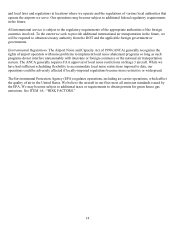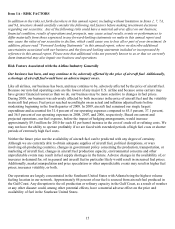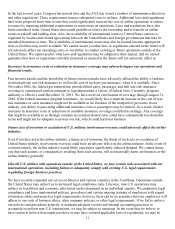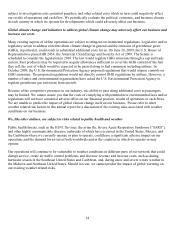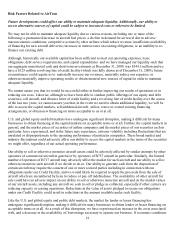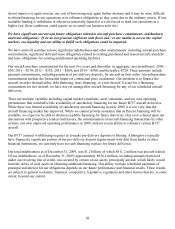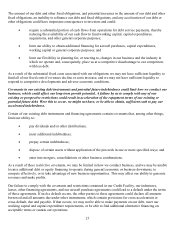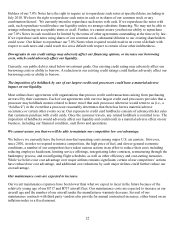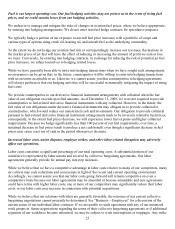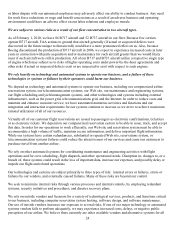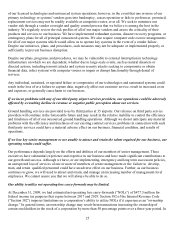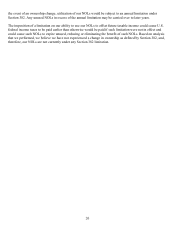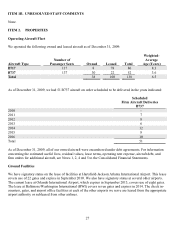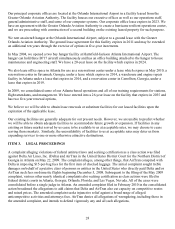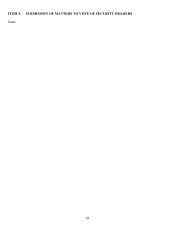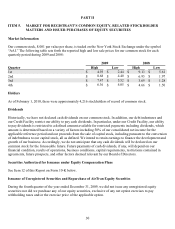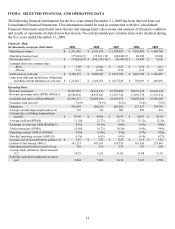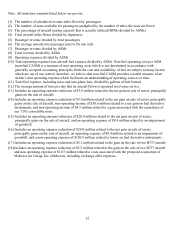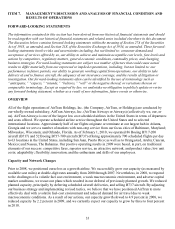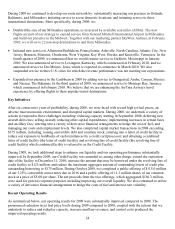Airtran 2009 Annual Report Download - page 33
Download and view the complete annual report
Please find page 33 of the 2009 Airtran annual report below. You can navigate through the pages in the report by either clicking on the pages listed below, or by using the keyword search tool below to find specific information within the annual report.24
or labor dispute with our unionized employees may adversely affect our ability to conduct business. Any need
for work force reductions or wage and benefit concessions as a result of an adverse business and operating
environment could have an adverse effect on our labor relations and employee morale.
We are subject to various risks as a result of our fleet concentration in two aircraft types.
As of February 1, 2010, we have 86 B717 aircraft and 52 B737 aircraft in our fleet. Because few carriers
operate B717 aircraft, FAA actions to ground that aircraft generally (if actual or suspected defects were
discovered in the future unique to that aircraft) would have a more pronounced effect on us. Also, because
Boeing discontinued the production of B717 aircraft in 2006, we expect to experience increased costs in later
years in connection with parts acquisition and/or maintenance for such aircraft greater than we would likely
incur if such aircraft were still in production. All of our B717 and B737 aircraft utilize a respective single type
of engine which may subject us to risks of higher operating costs under power-by-the-hour agreements and
other risks if actual or suspected defects exist or are suspected to exist with respect to such engines.
We rely heavily on technology and automated systems to operate our business, and a failure of these
technologies or systems or failures by their operators could harm our business.
We depend on technology and automated systems to operate our business, including our computerized airline
reservations system, our telecommunication systems, our Web site, our maintenance and engineering systems,
our flight scheduling and yield management systems, and other technologies and systems including external
infrastructure, such as the power grid, telecommunications grid, and the Internet. In order to reduce costs and
maintain and enhance customer service, we have automated numerous activities and functions and our
integration and interaction requirements for our systems continue to increase as we strive to achieve maximum
rational utilization of all of our resources.
Virtually all of our customer flight reservations are issued to passengers as electronic confirmations, ticketless
or as electronic tickets. We depend on our computerized reservation system to be able to issue, track, and accept
this data. In order for our operations to work efficiently, our Web site and reservation system must be able to
accommodate a high volume of traffic, maintain secure information, and deliver important flight information.
While our systems have certain redundancies, substantial or repeated Web site, reservations system, or
telecommunication systems failures could reduce the attractiveness of our services and cause our customers to
purchase travel from another airline.
We rely on other automated systems for coordinating maintenance and engineering activities with flight
operations and for crew scheduling, flight dispatch, and other operational needs. Disruption in, changes to, or a
breach of, these systems could result in the loss of important data, increase our expenses, and possibly delay or
impede our flight and related operations.
Our technologies and systems are subject primarily to three types of risk: internal errors or failures, errors or
failures by our vendors, and externally caused failures. Many of these risks are beyond our control.
We seek to minimize internal risks through various processes and internal controls, by employing redundant
systems, security initiatives and procedures, and disaster recovery plans.
We rely on outside vendors and licensors for a variety of technological services, products, and functions critical
to our business, including computer reservation system hosting, software design, and software maintenance.
Our use of outside vendors increases our exposure to several risks. If one of our major technology or automated
systems vendors fails to perform adequately, we may experience increased costs, delays, or negative public
perception of our airline. We believe there currently are other available vendors and alternative systems for all


